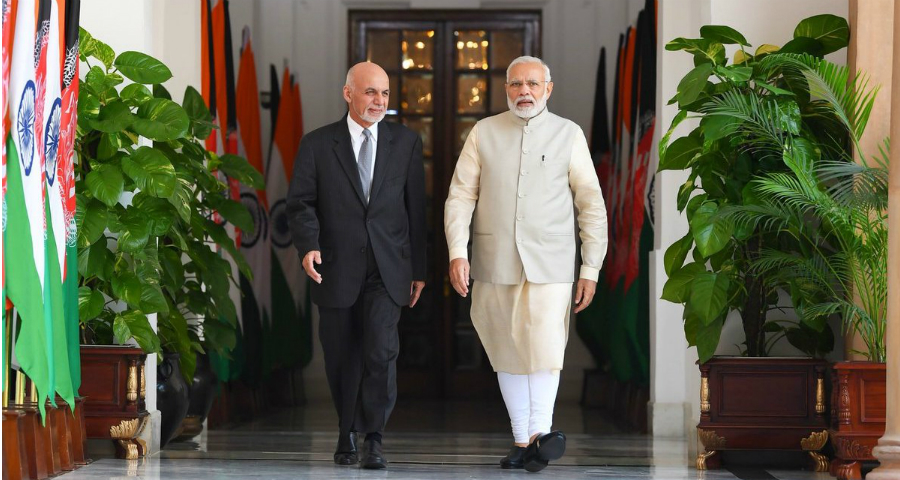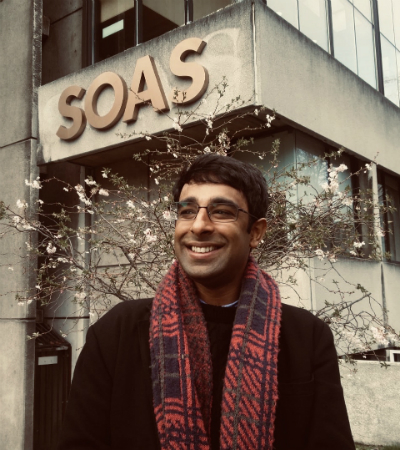The ‘India Question’ in Afghanistan
Editor’s Note: Pakistan and the United States are not the only important outside actors in Afghanistan. India has long courted the government in Kabul, and Islamabad views this potential relationship with alarm. Avinash Paliwal of SOAS explains India’s policies regarding Afghanistan and discusses how this might shift in the years to come.
Daniel Byman
***

Published by The Lawfare Institute
in Cooperation With

Editor’s Note: Pakistan and the United States are not the only important outside actors in Afghanistan. India has long courted the government in Kabul, and Islamabad views this potential relationship with alarm. Avinash Paliwal of SOAS explains India’s policies regarding Afghanistan and discusses how this might shift in the years to come.
Daniel Byman
***
India welcomed the cancellation of U.S.-Afghan Taliban peace talks in Doha. In an expression of support for Kabul, which was ostracized from the talks, New Delhi asserted that any future process on the issue must include “all the sections of the Afghan society including the legitimately elected government.”
On the face of it, India reiterated a long-standing position of supporting Kabul against the Pakistan-sponsored Taliban. But what makes this position interesting is the fact that India’s relations with Kabul have undergone a shift since 2014.
When the Afghan government reached out to the Taliban in 2015, India viewed Afghan president Ashraf Ghani’s desire for talks as a “tilt” toward Pakistan, antithetical to India’s strategic interests. In response, New Delhi canceled high-level bilateral and multilateral engagements with Kabul. By early 2018, though, when Ghani made a similar overture and offered talks without any preconditions, India welcomed the move and sought international support for it. India’s support for the recent cancellation of further negotiations has more to do with its concern regarding Kabul’s exclusion than an aversion to talks with the Taliban.
India’s change in policy from 2015 to 2018 came despite the security situation on the ground continuing to militate against Kabul; the Taliban not only has made territorial gains but also is engaging diplomatically with the United States, China, Russia and Iran. Understanding New Delhi’s shift requires considering India’s enduring role in Afghanistan as a powerful neighbor that may not be central to the country’s politics but is also not a peripheral bystander.
This is best captured in India’s journey from being central to Trump’s Afghanistan strategy in 2017, to becoming marginal during the U.S.-Taliban peace talks in 2018 and 2019. India’s relevance has increased again with the cancellation of the peace talks and New Delhi’s abrogation of Article 370 in Jammu and Kashmir, which has complicated Pakistan’s strategy of seeking U.S. mediation on Kashmir in return for a peaceful and timely withdrawal from Afghanistan.
Driver of India’s Afghanistan Policy
The core driver of India’s Afghanistan policy is to ensure a continuing strategic balance between Afghanistan and Pakistan. Given the power differential between Kabul and Islamabad, this means that India wants to ensure that Pakistan does not manipulate the terms of peace talks and undermine Indian interests in Afghanistan. At a minimum, India wants to protect the safety of Indians working in Afghanistan and the security of India’s missions in the country, and prevent Pakistan’s security agencies from using Afghan soil for training anti-India radicals. Balance, for India, means ensuring that Afghanistan has strong strategies to cope with Pakistani pressure in the face of overwhelming power imbalance.
India is not averse to Kabul reconciling with the Taliban—as far as New Delhi is concerned, the Taliban is not the central problem. Pakistani influence on the Taliban and the latter’s inability to liberate itself from such influence is the main issue. Pakistan understands this clearly: One of the demands that Pakistan consistently makes from Kabul in return for cooperation is reduction in Indian diplomatic, intelligence and developmental presence in Afghanistan.
India Alienated
In 2015, India lost faith in Ghani’s ability to counter Pakistani pressure. Not only did the Afghan president shelve pending requests for Indian military supplies, but he also pushed New Delhi to the “fourth circle” of his “five-circle” foreign policy—a demotion that placed the relationship alongside other low-priority Asian states. This was accompanied by a lack of clarity about the United States’s Afghanistan policy; Washington, D.C.’s desire to withdraw combat troops despite continuing Taliban offensives; and Pakistan’s demand for Kabul’s support in cracking down against elements of the Tehrik-e-Taliban Pakistan (TTP) operating from Afghan soil.
Under pressure from the Pakistani military, Afghan security forces clamped down on the TTP and also allowed operatives from Inter-Services Intelligence, the Pakistani intelligence agency, to interrogate TTP prisoners in Afghan prisons. None of these favors from Kabul generated any returns in terms of reduction in Taliban or Islamic State violence, or opened the possibility of direct talks between Kabul and the Taliban. The eventual signing of a memorandum of understanding between Afghan and Pakistani intelligence agencies in May 2015, then, was sufficient to generate Indian pushback.
India’s powerful national security adviser, Ajit Doval, pinned Pakistan’s actions on their baseless theory that India foments violence in Pakistan via Afghanistan. Speaking bluntly in May 2015 he said, “What Pakistan wanted [from the MoU] was to get an assurance and put pressure on Afghanistan, so that they will not allow their territory to be used for any security-related work by India. That is the crux of it. This is based on a faulty assumption that India probably uses Afghan soil or Afghan nationals for its security purposes.”
Soon after Doval’s statement, as a signal of intent to Kabul, India refused to host a high-level committee meeting to review the 2011 Strategic Partnership Agreement, and the external affairs minister refused to attend the Sixth Regional Economic Cooperation Conference on Afghanistan being held in Kabul. Despite Kabul’s assurances, New Delhi viewed Ghani’s outreach to Pakistan as an impending strategic “tilt” toward Islamabad that would come at the cost of Afghan lives and Indian interests.
The Balance Shifts
In contrast, Kabul’s 2018 overture to the Taliban was backed by a commitment made by President Trump in 2017 to maintain U.S. troop presence in Afghanistan on the basis of “conditions on the ground—not arbitrary timetables.” Simultaneously, Trump elevated India’s position as a key partner in Afghanistan’s developmental sector (and also suggested that India deploy troops as well, which India refused).
Unlike in 2015, Ghani took India into confidence in 2018 before calling for dialogue and then reached out to the Taliban directly, rather than going through Pakistan. His conduct earned Indian support for the talks despite the erosion of Kabul’s control over large territorial pockets across the country.
Ghani’s position between India and Pakistan had changed critically in the interim between attempts to negotiate. The first round of outreach fell apart in August 2015, when a series of powerful blasts hit Kabul and news of Mullah Omar’s death two years prior finally leaked to the press. After this rupture, Ghani became a virulent critic of Pakistan and began rebuilding trust with India.
By October 2015, Ghani had elevated India to the first circle of his five-circle foreign policy, and in November, indicating a clear shift in position, he directed his national security adviser, Mohammad Hanif Atmar, to visit New Delhi and finalize India’s “gift” of four Mi-25 attack helicopters that had been shelved earlier in the year. Though of limited strategic value, the helicopters sent a powerful signal to the region about India’s position on Afghanistan.
Without doubt, Ghani remained politically weak, faced dissent from within the government and has been unable to quell the Taliban insurgency. Nonetheless, the change in his position vis-a-vis Islamabad addressed the core driver of India’s Afghanistan policy. When combined with U.S. military muscle, Kabul’s approach on the issue of talks with the Taliban generated a degree of confidence in India that Kabul is unlikely to surrender.
India’s Options
The sidelining of Kabul in the Doha peace talks between the United States and the Taliban has been equally isolating for India. New Delhi’s refusal to open official channels with the Taliban when the United States was doing so made many observers wonder about the soundness of India’s position. With U.S. withdrawal risking the collapse of the Kabul government, India’s exclusive support for Ghani seemed myopic.
Throughout 2018 and 2019, India lobbied the United States to not strike a deal with the Taliban and jeopardize the gains (however limited) made since 2001. It also established private channels with the Taliban to better understand whether the group would be able to liberate itself from Pakistan’s influence. Lack of clarity on the Taliban’s position led India to calculate that opening official channels with the group was a high cost/low benefit move that would help the Taliban more than Kabul.
India’s support for Kabul at a moment when it is most vulnerable to a Pakistan-enabled Taliban onslaught and Trump’s electoral short-sightedness, is its way of signaling its intent and attempting to ensure the balance that it seeks between Afghanistan and Pakistan. This strategy seems to be working for now—at least while talks with the Taliban remain on ice. But open hedging by India is likely to accelerate Kabul’s collapse rather than stem the Taliban tide.
The mistrust generated among the Taliban by Trump’s last-minute cancellation of talks will ensure that a similar process does not restart soon. This affords New Delhi time and space to assess future policy options for when the United States does withdraw from Afghanistan. India could either opt for partisanship and support factions staunchly at odds with the Taliban and Pakistan, or it could adopt a conciliatory approach and engage with whomever comes to power in Kabul, including the Taliban. An Afghanistan run by Pakistan-supported proxies hostile to India will necessitate partisanship, but if the post-withdrawal government is receptive to India’s interests, it is likely to evoke a conciliatory response from New Delhi. The direction of India’s Afghanistan policy after the U.S. withdrawal will be determined by the nature of the withdrawal and the balance of power between Kabul and Islamabad when that day comes.





